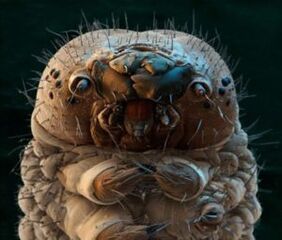
All kinds of parasites in the human body have a detrimental effect on his health. It infects the organs, feeds on nutrients necessary for human life, and releases harmful toxins. Therefore, it is very important to get rid of them in time.
The human body is affected by various parasites, some of which live inside the body and some on the surface. They differ in size, ways of entering the body, and the characteristics of their vital activities.
What parasites live in the human body? How to get rid of them? What are the preventive measures? These issues will be discussed below.
Classification of parasites
Human parasites are very common, they are divided into groups:
- Endoparasitesare called parasitic organisms inside a person. This group, in turn, is divided into protozoa (consisting of one cell) and helminths (worms). The simplest parasites in the human body are amoeba, lamblia, Trichomonas, toxoplasmosis. As for worms, there is still a division into roundworms (nematodes), flat and tapeworms.
- Ectoparasites- these are organisms that parasitize on the surface of the human body - lice, ticks, fleas, insects. In addition to feeding on human blood and causing great discomfort (bites, burns, skin wounds), they carry very dangerous diseases: typhoid, anthrax, trypanosomiasis and others.
Single-celled parasites:
- Giardia. . . Giardiasis infection is a fecal-oral mechanism. Cysts (not yet formed, covered with a protective membrane) spread to vegetables, fruits and other foods after they are removed from the anus of a sick person. Through poorly washed hands, stagnant water, and insufficiently washed fruits and vegetables, the cysts enter the human oral cavity, from where they safely reach the intestines, become adults again, and multiply again. The result is a bad period that will last until adequate treatment and hygiene measures are followed. Symptoms of the disease are weakness, fatigue, headache, diarrhea, abdominal pain and bloating. There may be itching in the anus, skin rash, bronchial asthma. It is characterized by pathological weight loss, anemia and weakened immune system. Treatment is with antiprotozoal drugs. Dosage is determined by a physician.
- Toxoplasma. . . Infection with this protozoa occurs through contact with infected pets. In this case, a human is an intermediate host, because the sexual development of the parasite takes place in the animal's body. The disease manifests itself with a prolonged rise in temperature to subfebrile levels, signs of general intoxication, the patient develops enlarged lymph nodes, joint and muscle pain. There is also dysfunction of the gastrointestinal tract and visual organs, the central nervous system may suffer, there are signs of heart disease and endocrine system. Complex treatment is prescribed - tetracycline antibiotics and sulfanilamides.
- Trichomonas. . . Trichomonas is sexually transmitted, the risk of contact is minimal, but it is still there. Symptoms of the disease in women are itching, redness of the genitals, burning sensation and foamy discharge. Men may have difficulty urinating and have a discharge. Treatment - anti-trichomonas drugs.
Pinworm is an intestinal parasite
The most common internal parasites are pinworms. They live in the intestines and cause a disease called enterobiasis. This type of parasite affects not only humans but also apes. Risk group - children of preschool age, according to statistics, enterobiasis is diagnosed in half of children aged 2 to 10 years.
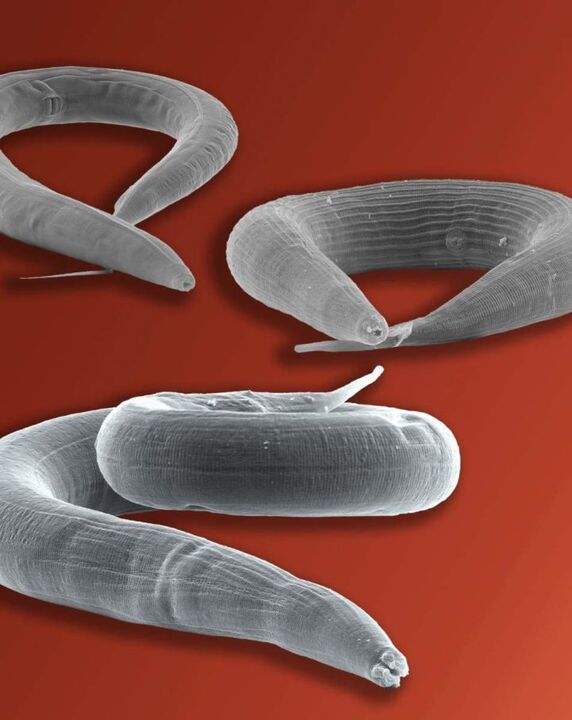
Worms are transmitted from person to person, you can be infected by any object used by a sick person or by shaking hands. The main condition for the transfer of pinworm eggs is not washing hands after contact, especially before eating. Worms, or rather their eggs, are carried by flies and cockroaches.
Pinworms can live only in the intestines, especially in the small intestine, colon and intestines. For mating, the parasites crawl out of the female anus and select the gut to lay eggs in the anus. Symptoms of pinworms in the body are itching in the anus, allergies, fatigue, anemia, abdominal pain, fatigue.
Anthelmintics are prescribed to treat enterobiosis. Pinworm prevention is based on hand hygiene. They should be washed after visiting any public place.
Roundworms are roundworms
The length of an adult can reach 40 cm. Roundworms live in the human gut, lay their eggs naturally, and then continue to grow in the soil until they enter the human body. Dirty hands and unwashed vegetables and fruits are ways to infect roundworms. Roundworm eggs are covered with a shell that does not melt in the human stomach and allows the roundworms to survive and fall into the developing intestines of adults.
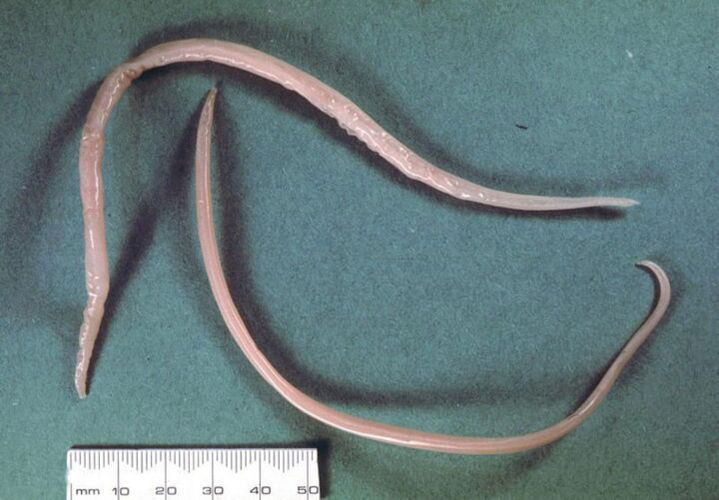
Ascariasis can be asymptomatic for a long time. Then symptoms appear, depending on the location and stage of development of the parasite. First, in the migratory stage of ascariasis, the patient is concerned about fever, cough with sputum, skin rash, migraine, enlarged lymph nodes, liver and spleen may appear. In the latter stage, when the parasite has already entered the intestines, fecal disorders are observed (symptoms such as dysentery, cholera, typhoid fever may be present). There are painful sensations in the abdomen, a sharp weight loss and fatigue.
Wide-band worm
Infection with this parasite occurs through fish. This is the intermediate owner of the worm. You do not need to eat for the infection, sometimes it is enough to come in contact with infected fish. Therefore, it is very important to handle your hands, knives and boards very carefully after cutting the fish.
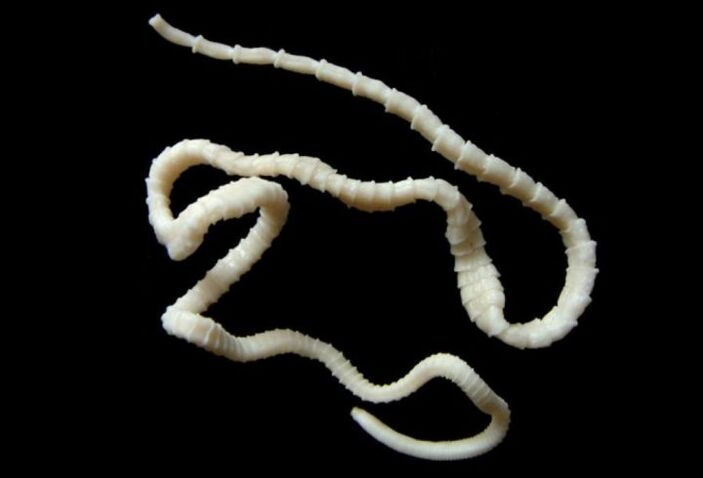
Neither worms nor larvae are transmitted from a sick person to a healthy person. Symptoms of infection include nausea, vomiting, abdominal pain, increased or decreased appetite, and dyspepsia. The first signs of the disease may appear a month or two after infection. As a result of long-term presence of the parasite in the human body, pale skin, headache, increased heart rate, decreased blood pressure, weakness, anemia occur. The treatment is aimed at killing the worm. Anthelmintics are used for this.
Beef ribbon
The cow worm can grow up to 12 m in length and is a hermaphrodite that can produce more than 100, 000 eggs laid in the feces. The eggs fall to the ground, and then on the plants, these plants are eaten by cattle. In an animal's body, the egg turns into larvae localized in the muscles. If a person eats contaminated beef, the larvae enter the intestines. Larvae are not transmitted from person to person.
Adult worms have a body with four suction heads, a neck and segments. The number of segments is constantly increasing, the adult segments can separate from the worm and come out of the human intestine.
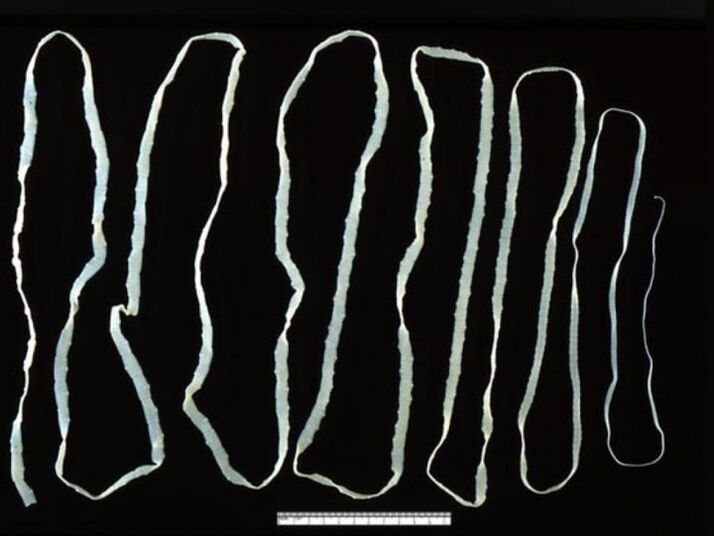
Symptoms of the disease are nausea, vomiting, dyspeptic disorders, increased salivation, dizziness, weakness, irritability, fatigue, abdominal pain of unknown localization, allergies, fluctuations in appetite.
There is a 3-step scheme for removing cow tape from the body: preparation (cleansing the body), treatment with antiparasitic drugs, recovery (diet, herbal medicine).
The pig tied the ribbon
A person can become infected with pork worms through dirty hands, poorly cooked meat, dirty water, and an infected person can throw pieces of tapeworm and larvae around with vomit and feces.
The worm can live in the human body for 15-17 years, attaches to the intestinal mucosa, and the larvae can spread throughout the body through the bloodstream and attach to any organ. It is especially dangerous for larvae to enter the brain.
Pigs are the intermediate host; People who come in frequent contact with raw meat are more at risk of contracting this parasite. Pigs can be infected by contact with both the chain and by eating meat that has been sufficiently heated. The meat must be cooked for a long time or frozen for 2-3 weeks in order to destroy all the larvae of the tapeworm.
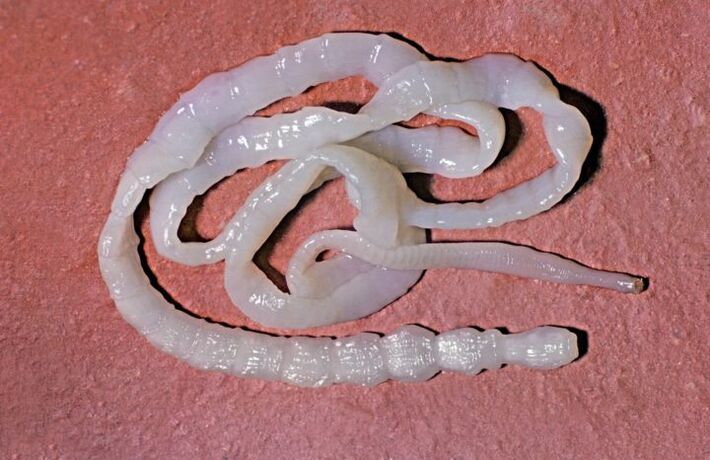
The pig tapeworm infects the small intestine, liver, brain, visual organs, muscles, and so on. If the tapeworm affects vital organs, then a person can be paralyzed or even die.
Symptoms of swine fever: allergic reactions, abdominal pain, nausea and vomiting, weakness, dizziness, headache, weight loss, itching in the anus. The worm infects the intestinal mucosa, so the symptoms are very similar to enteritis.
Treatment consists of taking drugs that have a paralyzing effect on the worm, which in turn can not remain in the intestinal wall and exits. But at the same time, it emits large amounts of toxins that can cause anaphylactic shock in humans. Therefore, treatment should be carried out only under the supervision of a physician.
Parasites in the mouth
The parasites in the human mouth can be represented by the following types:
- trichomonas;
- oral ameba;
- Diptera larvae (oral miyaz).
The clinical picture may be as follows:
- allergies;
- weakness, weight loss;
- bad breath;
- feeling of confusion in the larynx;
- itching and sweating;
- nausea, loss of strength.
Worms living in the mouth can destroy teeth and create purulent deposits on the mucous membranes and tongue. Treatment is prescribed only by a doctor who takes into account the existing symptoms and types of parasites. A prerequisite for treatment is the examination of all people in contact with the patient.
Summary
Above, not all of them are considered to be the most common parasites that can live in the human body. It is important to understand the great danger of this neighborhood: worms in a person can cause very serious consequences and, consequently, the death of their owners. Therefore, it is very important to diagnose and get rid of parasites in time. As for preventive measures, they are mainly hygiene and quality roasting of meat.




































